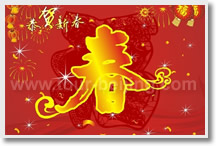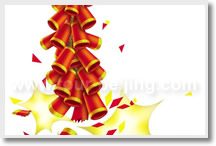Spring Festival
Beliefs during the New Year Period – Chinese Folklore

Good Luck:
—Opening windows and/or doors is considered to “bring in” the good luck of the new year.
—Switching on the lights for the night is considered good luck to “scare away” ghosts and spirits of misfortune that may compromise the luck and fortune of the new year.
—Candy is eaten to ensure the consume a “sweet” year.
—It is important to have the house completely clean from top to bottom before New Year’s Day for good luck in the coming year.
—Some believe that what happens on the first day of the New Year reflects the rest of the year to come. Asians will often gamble at the beginning of the year, hoping to get luck and prosperity.
Bad Luck:
—Buying a pair of shoes is considered bad luck amongst some Chinese. The character for “shoes” is a homophone for the character for “rough in Cantonese, or “evil” in mandarin Chinese.
—Buying a pair of pants is considered bad luck. The character for “pants” is a homophone for that for “bitter” in Chinese.
—A hair-cut is considered bad luck. The character for “hair” is a homophone for the character for “prosperity”.
—Washing hair is also considered to be washing away one’s own luck.
—Sweeping the floor is usually forbidden on the first day, as it will sweep away the good fortune and luck for the new year.
—Talking about death is inappropriate for the first few days of Chinese New Year, as it is considered inauspicious as well.
—Buying books is bad luck because the character for “book” is a homophone to the character for “lose” or “fail”.
Special Foods in Spring Festival – Chinese Folklore
In China, people from north and south have different habits about the foods they ear on the Spring Festival. Among the foods most popular in south China is Niangao (literally “year cake”); while in the north, the most common food for the Spring Festival is Jiaozi (or dumpling).
Niangao is a rice pudding prepared from glutinous rice. In Chinese, gao or cake, is a homonym for “high”. Thus by niangao, the Chinese are in fact expressing their hope for progress, promotion and improvement in life year by year.
In north China, people usually eat Jiaozi (or dumplings), which is shaped like a crescent moon. This dumpling consists of meat and /or vegetable filling wrapped into a thinly rolled piece of dough, which is then sealed by pressing the edges together. Common dumpling meat fillings include pork, mutton, beet, chicken, fish, and shrimp which are usually mixed with chopped vegetables.
The shape of Jiaozi resembles a Chinese gold or silver ingot; therefore they symbolize good fortune in the coming year. Traditionally, families get together to make jiaozi for the Chinese New Year.
Things Chinese Do in Spring Festival – Chinese Folklore
1.Prepareation
Usually the preparation starts a month before the New Year, Chinese family give their home a thorough cleaning, known as “spring-cleaning”. It is believed the cleaning sweeps away bad luck of the preceding year and makes their homes ready for good luck. Brooms and dustpans are put away on the firs day so that good luck can not be swept away.
The preparation also includes decorating the house, buying new clothes, preparing enough food for at least two weeks. The decorations are highly symbolic with a lot of lucky words, printed paintings and red colors everywhere. Kids are busy in shopping for different kinds of firecrackers. Everyone gets a haircut before the New Year. So everything and everyone looks new and fresh on the New Year.
2. Reuuion Dinner
The New Year’s Eve is the time for families. Usually there is a reunion dinner held for members of the family, near and far, who have got together for celebration. The venue will usually be in the home or near the home of the most senior member of the family.
The reunion dinner is very sumptuous and full of symbolic meanings. Traditionally it includes chicken and fish. Fish is included, but not eaten up completely, because a very popular Chinese phrase–nian nian you yu, which means “may there be surpluses every year”, sounds the some as “may there be fish every year”.
Most Northerners serve dumplings, called “jiaozi” in Chinese, as the main dish in this festival season and many Chinese around the world do the same. It is believed that dumplings resemble ancient Chinese gold or silver ingots.
Everyone, even kids, drinks a little “jiu” (usually hard liquor), which symbolizes longevity since Jiu has the same pronunciation as “longevity” in Chinese.
3. Firecrackers

Bamboo stems filled with gunpowder that were burnt to create small explosions were once used in ancient China to drive away evil spirits. In modern times, this method has eventually evolved into the use of firecrackers during the restive season. Firecrackers are usually strung on a long fused string so it can be hung down. Each firecracker is rolled up in red papers, as red is auspicious, ith gunpowder in its core.
When the clock rings to announce the arrival of the New Year, many households set off fireworks at almost the same time, creating a thunderous roar and clouds of smoke. This usually lasts for a few hours. Some people will continue to play firecrackers occasionally throughout the first half of the first month.
This ceremonial use of firecrackers is meant to send off the old and usher in the new, and to scare away evil spirits as well.
4. Spring Couplets
It has been a long-preserved custom over thousands of years for the Chinese people to celebrate the Spring Festival by hanging ups spring couplets (chunlian).
The spring couplet is a special type of duilian, or Chinese couplets, used during the Chinese New Year as part of its celebration. Usually, it consists of a couplet written on vertical strips of red paper in the best calligraphic style one can muster.
The first (called upper) line is posted on the right side of the front door. The second (called lower) line is posted on the left side o the front door. In addition, a third horizontal piece may be posted across an on top the door.
5. Door God Portraits
Besides spring couplets, door god portraits may also be put up on the doors of Chinese families during the Spring Festival. A door god portrait is a Chinese decoration placed on each side of an entry to a temple, home, business, etc., believed to keep evil spirits from entering.
In addition, it is also common to hang up calligraphic writing of the Chinese characters for “spring”, “wealth” and “blessing”. Some people tend to invent these writings because, in Chinese, the character for “inverted” is a homonym for that for “arrival”, thus signifying that spring, wealth or blessing has arrived.
6. Red Packets
Giving Hongbao or red packets during the Chinese New Year is another tradition. A red packet is simply a red envelope with money in it, which symbolizes luck and wealth.
Red packets are passed out during the Chinese New Year’s celebrations, from married couples or the elderly to unmarried juniors. It is common for adults to give red packets to children.
Red packets are also known as yasuiqian, during this period. Generally speaking, a married person can not turn down a child’s request for a red packet, because it means that this person would be “out of luck” in the new year.
The amount of money in the red packets may vary, but should be of even numbers, as odd numbers are associated with cash given during funerals.
7. New Year Greetings
The Chinese New Year is also the time for socializing. People usually wear new clothes and go out to visit and greet their relatives, friends and even neighbours, so the streets are filled with a lot of cheerful people. When they meet, they usually greet each other loudly and enthusiastically with auspicious words or phrases, such as “Happy New Year” (guo nian hao, or xin nian kuai le) and “congratulations and Be Prosperous” (gong xi fa cai).
Origin of Spring Festival – Chinese Folklore
It was recorded that Chinese began to celebrate the Chinese New Year, also known as the Spring Festival, from about 2000 BC, though the celebration were held on different times under different emperors.
Its origin is too old to be traced. Several explanations have been around. All agree, however, that character Nian, which means “year” in modern Chinese, was originally the name of a monster beat which stated to prey on people that night before the beginning of a new year.
The term “guo nian”, which may literally mean “survive the Nian”, becomes today “Celebrate the New Year” as the word “guo” in Chinese having both the meaning of “pass-over” and “observe”. The custom of putting up red paper and firing fire-crackers to scare away Nian is still around. However, people today have long forgotten why they are doing all this, except that they feel the color and the sound add to excitement of the celebration.
Questions & Answers:



